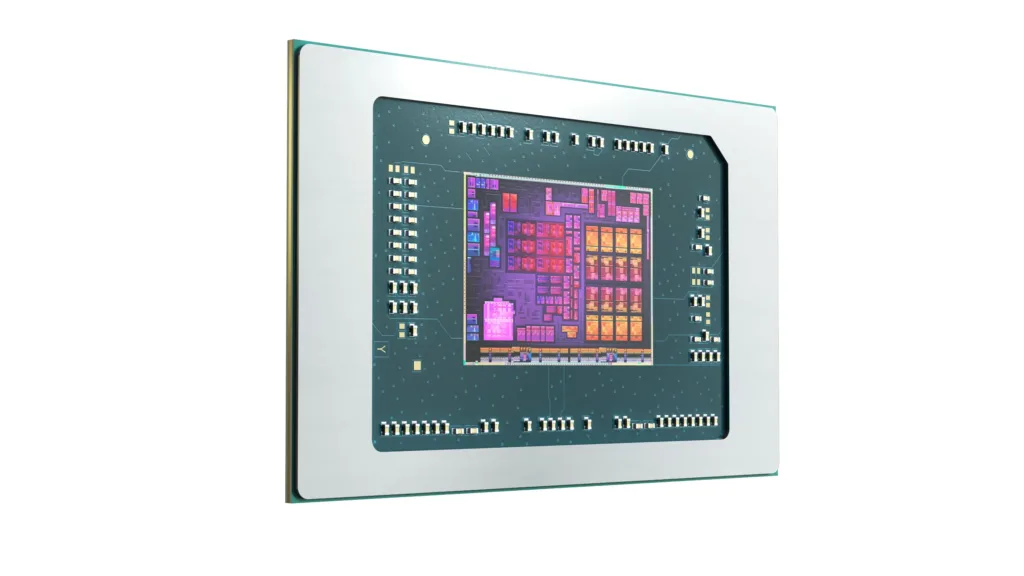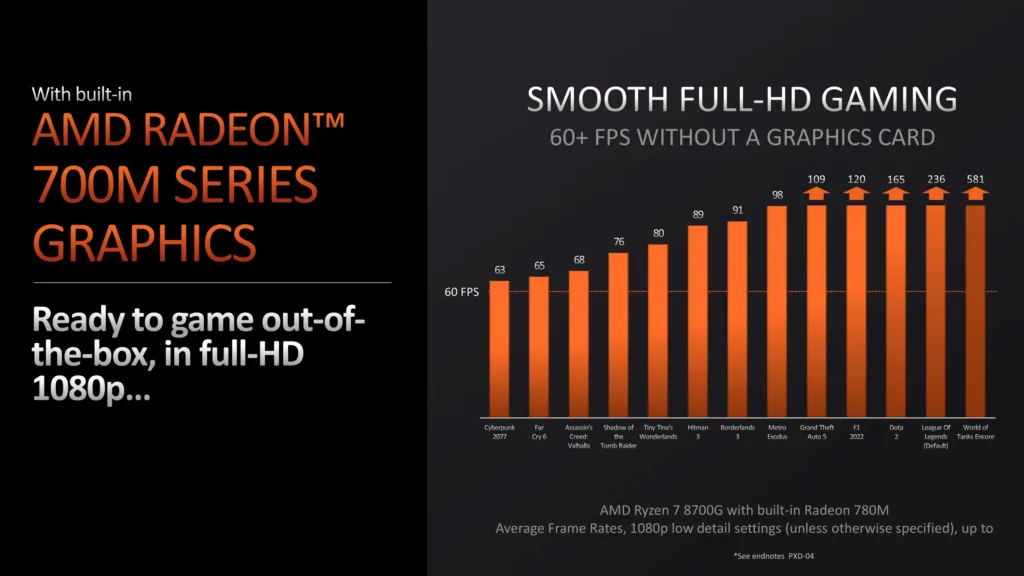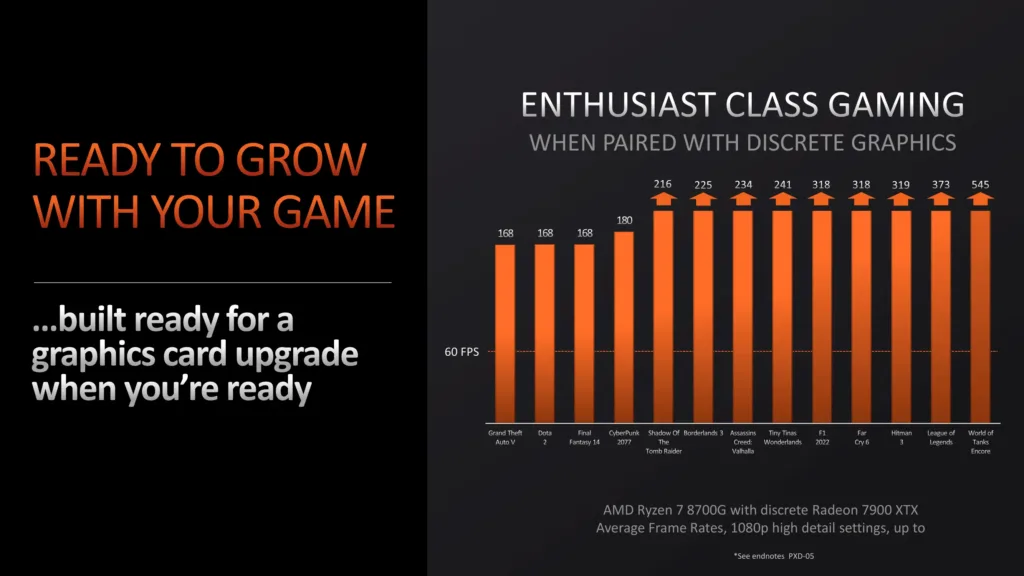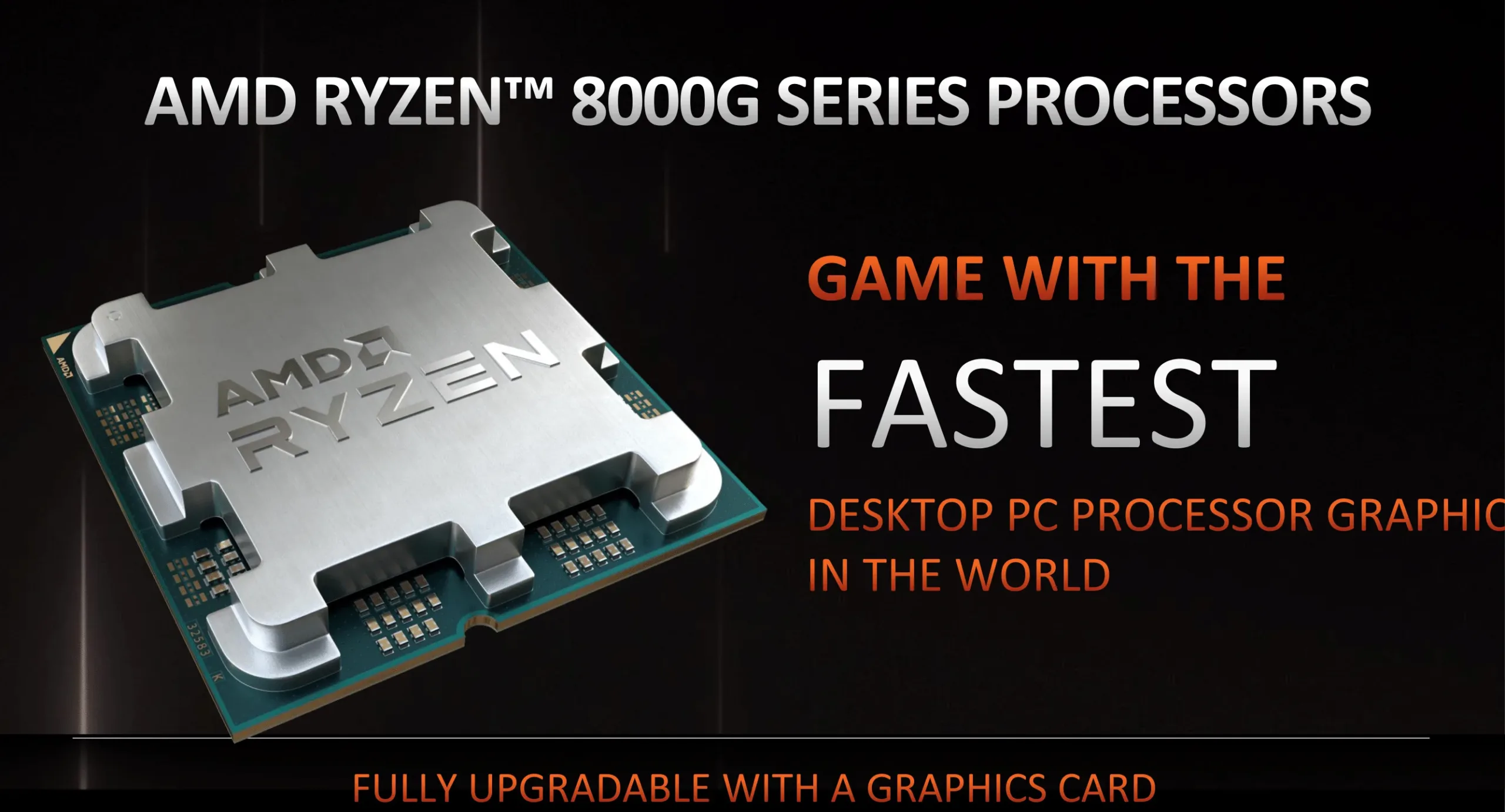Last Updated on July 12, 2024 by Team Yantra
At the CES 2024, AMD has made major headlines with the launch of the Ryzen 8000G desktop processor family, powered by the advanced Zen 4 architecture, Radeon integrated graphics, and Ryzen AI.
AMD also expanded the Ryzen 5000 Series with new models, including the much-anticipated Ryzen 7 5700X3D.
AMD’s Big Move: The Ryzen 8000G APU
The latest Ryzen 8000G lineup of Accelerated Processing Units (APUs) blends processing power of Zen 4 cores with the enhanced capabilities of Radeon RDNA3-based graphics and Ryzen AI NPU core for AI tasks. Ryzen 8000G series is based on AMD’s AM5 desktop platform.
Leading the pack is the Ryzen 7 8700G, an 8-core powerhouse equipped with Radeon 780M graphics, setting a new benchmark for integrated GPU performance.
Key Models and Specifications
- Ryzen 7 8700G: 8 Zen 4 cores, Radeon 780M, 16MB L3 Cache, 65W TDP, $329 MSRP
- Ryzen 5 8600G: 6 Zen 4 cores, Radeon 760M, 16MB L3 Cache, 65W TDP, $229 MSRP
- Ryzen 5 8500G: Mixed Zen 4 and Zen 4c cores, Radeon 740M, 16MB L3 Cache, 65W TDP, $179 MSRP
- Ryzen 3 8300G: Mixed Zen 4 and Zen 4c cores, Radeon 740M, 8MB L3 Cache, 65W TDP, OEM only

| AMD Ryzen 8000G Desktop Series | |||||||||
| Cores | Base Freq | Turbo Freq | GPU | GPU Freq | Ryzen AI (NPU) | L3 Cache (MB) | TDP | MSRP | |
| Ryzen 7 8700G | 8x Z4 | 4200 | 5100 | R780M 12 CUs | 2900 | Y | 16 | 65W | $329 |
| Ryzen 5 8600G | 6x Z4 | 4300 | 5000 | R760M 8 CUs | 2800 | Y | 16 | 65W | $229 |
| Ryzen 5 8500G | 2x Z4 4x Z4c | 3500 | Z4: 5000 Z4c: 3700 | R740M 4 CUs | 2800 | N | 16 | 65W | $179 |
| Ryzen 3 8300G* | 1x Z4 3x Z4c | 3400 | Z4: 4900 Z4c: 3600 | R740M 4 CUs | 2600 | N | 8 | 65W | OEM Only |
| *Currently OEM only (End of Q1 2024, other SKUs available 31/01/24 | |||||||||
The Ryzen 5 and Ryzen 3 models offer a tiered approach, catering to different performance needs and budgets. AMD’s unique strategy of using both Phoenix and Phoenix 2 silicon is similar to that of their 8000 mobile series processors
Performance and Efficiency: A Gaming Paradigm Shift
AMD promises ‘ready to game out of the box at 1080p’ performance levels. While this may not satisfy the ultra-high-resolution demands of some enthusiasts, it’s a great move, keeping in mind entry level gaming desktop.
Ryzen 7 8700G
At the top end, we have Ryzen 7 8700G, it has a 5.1 GHz turbo frequency with a 4.2 GHz base frequency. Being an APU, it includes the Radeon 780M integrated graphics, which is RDNA3-based and supports AMD’s latest features, such as Hyper-RX and Fluid Motion Frames.
The Radeon 780M has 12 CUs, with 768 shader units (1536 ALUs) with a clock speed of 2.9 GHz. The Radeon 780M along with Ryzen AI NPU and CPU cores form a trio of on-chip called AI engine. Giving the processor AI inferencing capabilities, which AMD claims provides up to 39 TFLOPS of performance.
Ryzen 5 8600G
Next is AMD Ryzen 5 8600G which is a one step down from the 8700G with a six full Zen 4 cores and a turbo core frequency of up to 5.0 GHz, while the base frequency runs at 4.3 GHz.
It also features AMD’s Radeon 760M RDNA3 integrated graphics cores, with 8 CUs and 512 shader units at 2.8 GHz.
Along with the Ryzen 7 8700G, the Ryzen 5 8600G also includes the Ryzen AI NPU engine block built into the silicon, with both SKUs making use of the technology AMD picked up from their acquisition of Xilinx in 2022.
AMD Ryzen 5 8500G.
Third up is the AMD Ryzen 5 8500G. The 8500G packs two full Zen 4 cores with 4 Zen 4c cores. Now, if you notice. 8500G has only 2 full version Zen 4 cores, rest 4 are smaller Zen 4c cores. This is AMD using Phoenix (2) silicon arrangement rather is where AMD Phoenix (1) which is used is flagships 8700G and 8600G.
Ryzen 5 8500G has a base clockspeed of 3.5GHz, while the Zen 4c cores can clock up to 3.7GHz, and the big cores can go all the way to 5.0GHz. The 8500G also does not have the Ryzen AI NPU, and its integrated GPU drops to the 4 CU Radeon 740M, with a peak GPU clockspeed of 2.8GHz.
With these specifications, the Ryzen 5 8500G is very similar to the Ryzen 5 8540U mobile processor, but with a higher 65 W TDP and adapted for use with AMD’s AM5 desktop platform
8300G
Last in the list is Ryzen 8300G which is the entry-level model and will only be available to system integrators and OEMs for now. It consists of one full Zen 4 core with three Zen 4c cores, and the single Zen 4 core can hit 4.9 GHz at turbo frequencies. Besides dropping more CPU cores, this chip also loses half of its L3 cache, bringing it down to 8MB of L3 joining the 4MB of L2 split amongst the CPU cores.
The AI Edge: Ryzen AI NPU
AMD’s focus on AI is more pronounced than ever with the inclusion of the Ryzen AI NPU in the Ryzen 7 8700G and Ryzen 5 8600G. This feature enhances on-chip generative AI performance and inferencing capabilities, a testament to AMD’s forward-thinking approach post their Xilinx acquisition in 2022.
The Ryzen 8000G Series is also the world’s first desktop processor with a dedicated AI engine.
AMD
Benchmarks and numbers
AMD’s in-house benchmarks show the Ryzen 7 8700G outperforming comparable Intel and NVIDIA setups in various tasks, from gaming to content creation.
Gaming
For AAA games such as Cyberpunk 2077, Far Cry 6, and Assassin’s Creed: Valhalla Ryzen 7 8700G framerate averaged above 60 fps. Other less demanding titles, such as F1 2022, Dota 2, and League of Legends, average over 100 fps. This shows that the combination of Phoenix based Zen 4 cores and the Radeon 780M graphics offers a pathway to affordable desktop gaming.


Compute
AMD’s performance claims, outperforming Intel’s 13th Gen Core i5-13400F with an NVIDIA GeForce 1650 in various benchmarks, are bold. While vendor-provided figures should be taken with caution, they indicate AMD’s confidence in competing against discrete GPU setups in the entry-level market.
Ryzen 8000G: The Balancing Act of Zen 4 and Zen 4c
The use of both Zen 4 and more power-efficient Zen 4c cores in the Ryzen 5 8500G and Ryzen 3 8300G represents a strategic decision by AMD. This allows for a balance between performance and power consumption, further diversifying their APU offerings.
The Ryzen 8000G series could potentially dominate the entry-level market, offering a compelling blend of performance and value. The pricing strategy ($179-$329) places these APUs within reach of a broad range of consumers, from casual gamers to content creators on a budget.
By leveraging the power of Zen 4 cores and Radeon RDNA3 graphics, along with AI capabilities. The implications for gamers and creators are profound, offering unprecedented performance at a more accessible price point. As these APUs hit the market, they are poised to redefine expectations and solidify AMD’s position as a key player in the desktop CPU landscape.
Availability of Ryzen 8000G series
According to AMD, the Ryzen 7 8700G will hit retail at $329, with the Ryzen 5 8600G coming in at $229, and the Ryzen 5 8500G rounding out the collection at $179. All three SKUs will be available to buy starting January 31st. The Ryzen 3 8300G will only be available to system builders, and even then it isn’t expected to start landing in systems until the end of Q1 2024.
AMD Ryzen 5000 Series: Refreshing the Legacy Socket AM4
In a parallel move, AMD has expanded its Ryzen 5000 Series, offering more choices for users of the AM4 platform. These processors are built on the “Zen 3” architecture, known for its high clock speeds and efficiency.
Processor launched
- AMD Ryzen 7 5700X3D: 8 Cores, 16 Threads, up to 4.1GHz Boost, 100MB Cache, $249
- AMD Ryzen 7 5700: 8 Cores, 16 Threads, up to 4.6GHz Boost, 20MB Cache, $175
- AMD Ryzen 5 5600GT: 6 Cores, 12 Threads, up to 4.6GHz Boost, 19MB Cache, $140
- AMD Ryzen 5 5500GT: 6 Cores, 12 Threads, up to 4.4GHz Boost, 19MB Cache, $125
The star of this expansion is the Ryzen 7 5700X3D, which incorporates AMD’s 3D V-Cache™ technology. This processor is specifically tailored for gamers, offering a massive 100MB of on-chip memory to deliver exceptional performance in gaming scenarios.
Availability of new Ryzen 5000 processors
The new Ryzen 5000 Series processors will also be available to DIY customers and SI partners starting January 31st, 2024.
AMD’s latest launches are set to create ripples in the desktop computing market. The Ryzen 8000G Series, with its AI capabilities, positions AMD as a leader in the evolving AI PC era. These processors are not only power-efficient but also pack a punch in terms of performance, making them suitable for a wide range of applications, from gaming to intensive workloads.
The expansion of the Ryzen 5000 Series is a strategic move to keep the AM4 platform relevant and appealing. The introduction of the Ryzen 7 5700X3D, in particular, is a clear indication that AMD is not just focusing on their newest platforms but also on providing value to users of their existing platforms.

Leave a Reply
You must be logged in to post a comment.